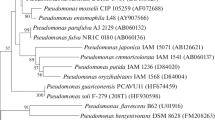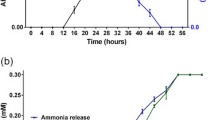Abstract
AParacoccus sp. which transforms aniline and different halogen-substituted derivatives under aerobic and anaerobic conditions was isolated from the soil. In experiments with14C-ring-labeled 4-chloroaniline, approximately 60% of the radioactive material disappeared from the growth medium after incubation under anaerobiosis within 48 hr, but under aerobic conditions no decrease of radioactivity in the growth medium was observed, although 4-chloroaniline was completely metabolized. Acetylation appears to constitute, especially under aerobic conditions, a major transformation mechanism by the bacterium, since almost 50% of the acetylated compound could be detected and identified if aniline, 2-, 3-, and 4-chloroaniline served as substrate. The formation of different metabolites under aerobic and anaerobic conditions clearly indicates the existence of two separate pathways in the metabolism of aniline compounds depending on the oxygen status of the environment.
Similar content being viewed by others
References
Bartha, R. 1971. Fate of herbicide-derived chloroanilines in soil.J. Agr. Food Chem. 19: 385.
Bartha, R., and Pramer, D. 1967. Pesticide transformation to aniline and azo compounds in soil.Science 156: 1617.
Bollag, J.-M. 1974. Microbial transformation of pesticides.Advan. Appl. Microbiol. 18: 75.
Bollag, J.-M., and Nash, C. L. 1974. Effect of chemical structure of phenylureas and anilines on the denitrification process.Bull. Environ, Contam. Toxicol. 12: 241.
Boyland, E., and Nery, R. 1964. Arylhydroxylamines. Part IV. Their colorimetric determination.Analyst 89: 95.
Briggs, G. G., and Ogilvie, S. Y. 1971. Metabolism of 3-chloro-4-methoxyaniline and some N-acyl derivatives in soil.Pest. Sci. 2: 165.
Kaufman, D. D., Plimmer, J. R., and Klingebiel, U. J. 1973. Microbial oxidation of 4-chloroaniline.J. Agr. Food Chem. 21: 127.
Kearney, P. C., and Plimmer, J. R. 1972. Metabolism of 3,4-dichloroaniline in soils.J. Agr. Food Chem. 20: 584.
Tweedy, B. G., Loeppky, C., and Ross, J. A. 1970. Metabolism of 3-(p-bromophenyl)-1-methoxy-1-methylurea (Metabromuron) by selected soil microorganisms.J. Agr. Food Chem. 18: 851.
Van Alfen, N. K., and Kosuge, T. 1974. Microbial metabolism of the fungicide 2,6-dichloro-4-nitroaniline.J. Agr. Food Chem. 22: 221.
Author information
Authors and Affiliations
Rights and permissions
About this article
Cite this article
Bollag, J.M., Russel, S. Aerobic versus anaerobic metabolism of halogenated anilines by aParacoccus sp.. Microb Ecol 3, 65–73 (1976). https://doi.org/10.1007/BF02011454
Issue Date:
DOI: https://doi.org/10.1007/BF02011454




